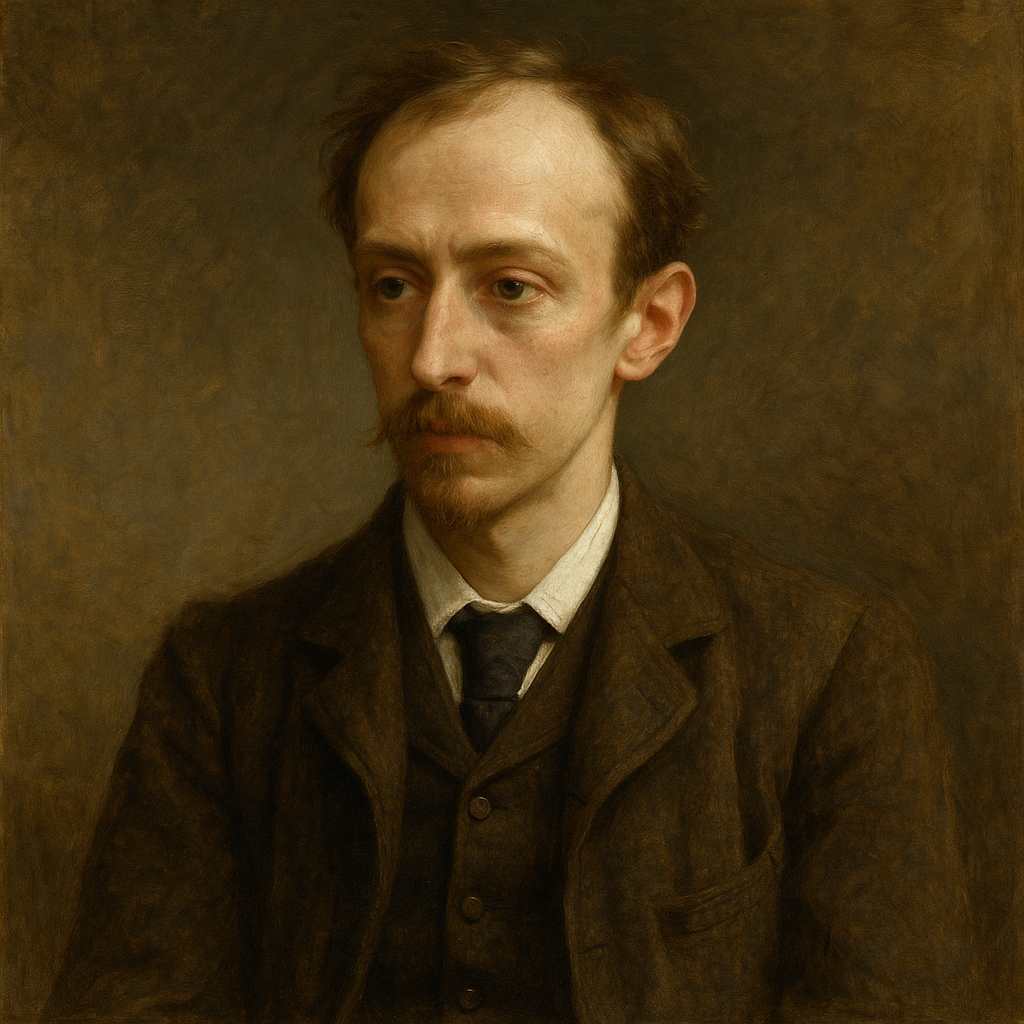To One in Bedlam
Ernest Dowson
1867 to 1900

With delicate, mad hands, behind his sordid bars,
Surely he hath his posies, which they tear and twine;
Those scentless wisps of straw that, miserable, line
His strait, caged universe, whereat the dull world stares.
Pedant and pitiful. O, how his rapt gaze wars
With their stupidity! Know they what dreams divine
Lift his long, laughing reveries like enchanted wine,
And make his melancholy germane to the stars'?
O lamentable brother! if those pity thee,
Am I not fain of all thy lone eyes promise me;
Half a fool's kingdom, far from men who sow and reap,
All their days, vanity? Better than mortal flowers,
Thy moon-kissed roses seem: better than love or sleep,
The star-crowned solitude of thine oblivious hours!
Ernest Dowson's To One in Bedlam
Introduction
Ernest Dowson's sonnet "To One in Bedlam" presents a poignant and complex exploration of madness, creativity, and the human condition. This poem, written in the late 19th century, exemplifies the decadent movement's fascination with themes of isolation, altered states of consciousness, and the tension between societal norms and individual expression. Through a masterful use of imagery, diction, and poetic structure, Dowson crafts a narrative that challenges our perceptions of sanity and invites us to consider the value of imagination in a world often dominated by mundane realities.
Historical and Literary Context
To fully appreciate the depth of Dowson's work, we must first consider its historical and literary context. The late Victorian era was a time of significant social and intellectual change, marked by advancements in science and psychology that began to reshape understanding of the human mind. Contemporaneously, the decadent movement in literature emerged as a reaction against the perceived banality of industrial society and the rigid moral codes of the time.
Dowson, as a key figure in this movement, often explored themes of disillusionment, escapism, and the pursuit of beauty and sensation. "To One in Bedlam" reflects these preoccupations, presenting madness not merely as a clinical condition but as a potential avenue for transcendent experience and artistic vision.
Form and Structure
The poem adheres to the structure of a Petrarchan sonnet, consisting of an octave (eight lines) followed by a sestet (six lines). This classical form provides a framework for Dowson to develop his ideas with precision and impact. The octave, with its ABBAABBA rhyme scheme, establishes the setting and introduces the central figure of the madman. The sestet, following a CDCDCD pattern, shifts focus to the speaker's perspective and the broader implications of the madman's condition.
This structural division mirrors the thematic progression of the poem, moving from external observation to internal reflection. The volta, or turn, occurs at the ninth line with the exclamation "O lamentable brother!", marking a transition from description to a more personal and empathetic engagement with the subject.
Imagery and Symbolism
Dowson's use of imagery is both vivid and multifaceted, serving to create a rich tapestry of meaning throughout the poem. The opening lines present us with the central figure, described as having "delicate, mad hands," an oxymoronic phrase that immediately establishes the tension between fragility and frenzy that characterizes the madman's existence.
The "sordid bars" and "strait, caged universe" evoke the physical confines of the asylum, but also serve as metaphors for the societal constraints placed upon the individual. In contrast, the madman's "posies" and "wisps of straw" become symbols of creativity and imagination flourishing even in the most barren of environments.
The celestial imagery that permeates the poem—"stars," "moon-kissed roses," and "star-crowned solitude"—elevates the madman's experiences to a realm of cosmic significance. This juxtaposition of the earthly and the celestial underscores the poem's exploration of transcendence through altered perception.
Diction and Tone
Dowson's choice of words is carefully calibrated to create a tone that oscillates between pity, admiration, and a kind of envious wonder. The use of words like "lamentable," "pitiful," and "melancholy" acknowledges the tragic aspect of the madman's condition. However, this is counterbalanced by terms such as "enchanted," "divine," and "laughing reveries," which imbue the subject's experiences with an almost mystical quality.
The speaker's attitude evolves throughout the poem, moving from an initial position of observational distance to one of identification and even aspiration. This shift is marked by increasingly empathetic language, culminating in the direct address of the sestet and the speaker's expressed desire to partake in the madman's visionary state.
Thematic Analysis
At its core, "To One in Bedlam" grapples with fundamental questions about the nature of reality, perception, and the value of conformity versus individual expression. The madman, despite his confinement, is portrayed as possessing a kind of freedom that eludes those in the "dull world" outside. His "rapt gaze" and "long, laughing reveries" suggest a richness of inner experience that stands in stark contrast to the "vanity" of those who "sow and reap" in the everyday world.
Dowson invites us to question conventional notions of sanity and madness. The poem suggests that what society deems as madness may, in fact, be a form of heightened perception or spiritual enlightenment. The madman's "melancholy germane to the stars" implies a profound connection to the cosmos that surpasses ordinary human experience.
Furthermore, the poem explores the role of the artist or visionary in society. The madman can be seen as a metaphor for the creative individual, whose unique perspective often places them at odds with societal norms. The "pedant and pitiful" observers who fail to understand the madman's inner world may represent critics or a broader public unable to appreciate artistic or philosophical innovation.
The Sonnet's Resolution
The sestet brings the poem to a powerful conclusion, with the speaker openly aligning himself with the madman's perspective. The phrase "Half a fool's kingdom" acknowledges the perceived folly of the madman's state while simultaneously attributing to it a kind of sovereignty. This kingdom, "far from men who sow and reap," represents an escape from the mundane concerns of everyday life.
The final lines present a bold assertion of the value of the madman's experiences. His "moon-kissed roses" and "star-crowned solitude" are deemed superior to "mortal flowers," "love," and even "sleep." This elevation of the madman's "oblivious hours" above fundamental human experiences and emotions is a radical statement, challenging readers to reconsider their own priorities and perceptions.
Conclusion
"To One in Bedlam" stands as a testament to Ernest Dowson's poetic skill and the depth of his engagement with themes of alienation, creativity, and the search for transcendent experience. Through its carefully constructed form, evocative imagery, and nuanced exploration of madness, the poem offers a critique of societal norms and a celebration of individual perception.
The work invites multiple interpretations, functioning simultaneously as a commentary on mental illness, a meditation on the nature of artistic vision, and an exploration of spiritual awakening. Its enduring power lies in its ability to challenge readers' assumptions and to offer a glimpse into a world where conventional boundaries of perception are dissolved.
In the broader context of Victorian literature and the decadent movement, "To One in Bedlam" exemplifies the period's fascination with altered states of consciousness and its questioning of established social and moral codes. Dowson's poem continues to resonate with modern readers, offering insights into the complex relationship between individual experience, societal expectations, and the pursuit of meaning in a world that often seems devoid of enchantment.
This text was generated by AI and is for reference only. Learn more
Want to join the discussion? Reopen or create a unique username to comment. No personal details required!



Comments
No comments yet. Be the first to comment!